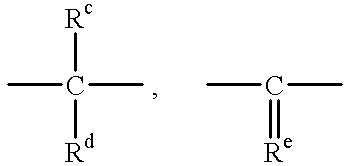Polycarbonate resin composition for optical use
a technology of polycarbonate resin and composition, which is applied in the field of polycarbonate resin for optical use, can solve the problems that the color tone stability of the polycarbonate resin cannot be improved sufficiently, and the quality of the polycarbonate produced is not always satisfactory for optical use, and achieves excellent molding properties and color stability during molding, excellent transparency, heat resistance and water resistance.
- Summary
- Abstract
- Description
- Claims
- Application Information
AI Technical Summary
Benefits of technology
Problems solved by technology
Method used
Image
Examples
reference examples 1-4
[0124] Continuous polymerization of bisphenol A (GE Plastics, Japan) and diphenyl carbonate (Enikemu) was performed according to the procedure described in JP Kokai 93-239334, and at the final step 7 of butyl p-toluenesulfonate was added to prepare constituent (A) polycarbonate. After the addition of 2 constituent (B) phosphorous acid with respect to the obtained constituent (A) polycarbonate (PS-converted weight-average molecular weight of polycarbonate: 17,500), constituent (D) glycerin monostearate (hereinafter abbreviated GMS), constituent (F) polyoxyethylene fatty acid ester (hereinafter abbreviated Atmer), constituent (C) butyl p-toluenesulfonate, and constituent (E) tris (nonylphenyl) phosphite (hereinafter abbreviated TNP), trimethyl phosphate, or phosphoric acid ester (tris (2,4-di-t-butylphenyl) phosphite, hereinafter abbreviated TBPP) were added in the quantities shown in Table 1, and after melting and kneading polycarbonate resin composition pellets were obtained using a...
example 1
[0129] Continuous polymerization of bisphenol A (GE Plastics, Japan) and diphenyl carbonate (Enikemu) was performed according to the procedure described in JP Kokai 93-239334, and at the final step 7 of butyl p-toluenesulfonate and 2 constituent (B) phosphorous acid were blended into the mixture to prepare constituent (A) polycarbonate (PS-converted weight-average molecular weight of polycarbonate: 17,500); constituent (D) GMS, constituent (F) Atmer, and constituent (C) butyl p-toluenesulfonate were added in the quantities shown in Table 2, and after melting and kneading polycarbonate resin composition pellets were obtained using a single screw extruder.
[0130] Using the polycarbonate resin composition pellets thus obtained, a 120 diameter CD was molded at a cylinder temperature of 380.degree. C., and as an evaluation of color tone stability of the CD, the change in color after 10 of retention at 380.degree. C. was measured from Delta YI.
[0131] The results are shown in Table 2.
examples 2 & 3
, Comparative Examples 1 & 2
[0132] Polycarbonate resin composition pellets were prepared in the same manner as in Example 1 except that the quantities of constituent (F) Atmer and constituent (C) butyl p used in Example 1 were changed as shown in Table 2. The pellets that were obtained were evaluated using Delta YI in the same manner as in Example 1.
[0133] The results are shown in Table 2.
2 TABLE 2 (B) (C) butyl Phosphorous .rho.-toluene- Delta acid sulfonate (D) GMS (F) Atmer YI Example 1 2 2 400 0 1.2 Example 2 2 1 400 75 1.61 Example 3 2 2 400 150 1.31 Comp. Ex. 1 2 400 0 2.09 Comp. Ex. 2 2 400 150 2.3
[0134] As can be clearly seen from Table 2, a polycarbonate resin composition showing excellent color tone stability can be obtained by the addition of the acidic compound.
PUM
| Property | Measurement | Unit |
|---|---|---|
| pKa | aaaaa | aaaaa |
| pKa | aaaaa | aaaaa |
| pKa | aaaaa | aaaaa |
Abstract
Description
Claims
Application Information
 Login to View More
Login to View More - R&D
- Intellectual Property
- Life Sciences
- Materials
- Tech Scout
- Unparalleled Data Quality
- Higher Quality Content
- 60% Fewer Hallucinations
Browse by: Latest US Patents, China's latest patents, Technical Efficacy Thesaurus, Application Domain, Technology Topic, Popular Technical Reports.
© 2025 PatSnap. All rights reserved.Legal|Privacy policy|Modern Slavery Act Transparency Statement|Sitemap|About US| Contact US: help@patsnap.com



